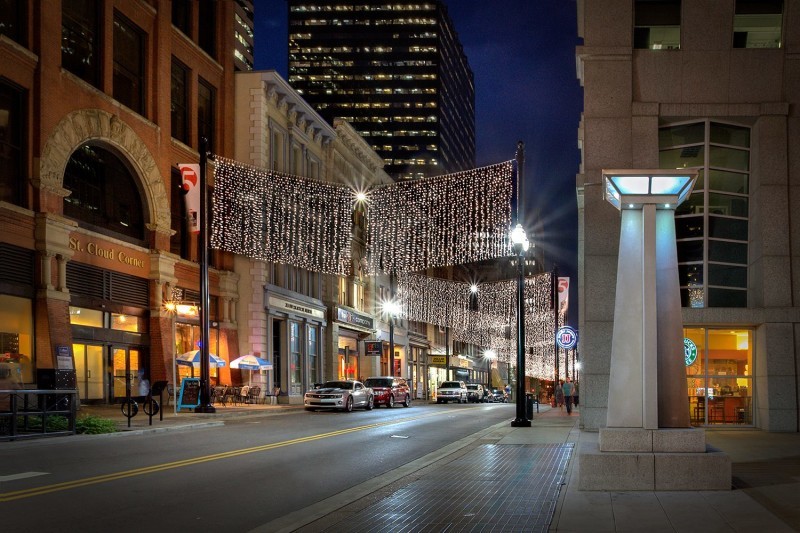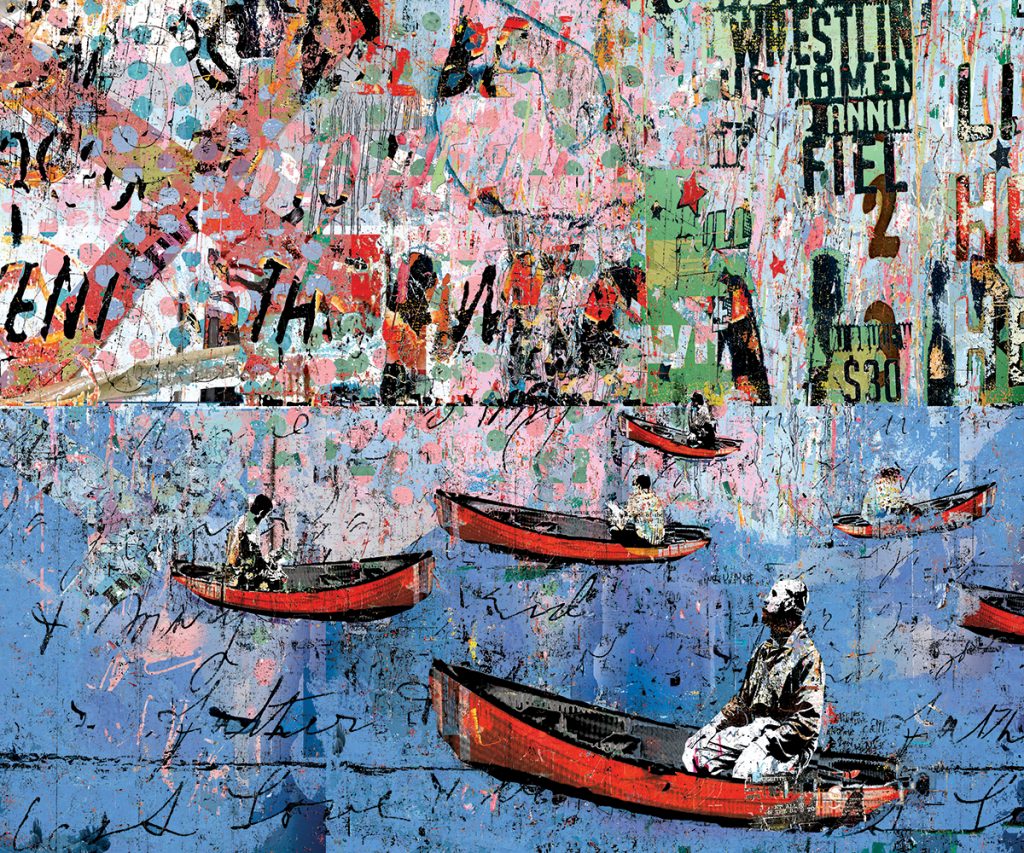
My first version of this piece featured calm waters and clear skies and appeared to be, on the surface, a contemplative piece. The idea for it came about, however, as a result of an unsettled time in my relationship. One morning, my wife and I were discussing an issue that had been dogging our marriage for some time. When she asked how I felt at that moment, I said, “Like a man in a boat alone.” From this conversation, I set out to create a piece with one man in one boat on a vast sea. The feel and look of the piece, however, was not right, aesthetically or psychologically. I then added more people in boats, all of whom were keeping to themselves (reading, looking away, etc. ). Upon completion, I saw this as a hopeful piece. While we are all “in a boat alone,” there are opportunities for connection all around us, including within relationships.
This brings me to the new version, Man in a Boat Alone: Contemplation. In this one, what looks like chaos fills the sky, however I see this “chaos” as light and energy. While we are all in a boat alone, we can still connect by bringing presence and contemplation to our lives, which in turn brings energy, creativity and light.
As we were traveling across Mexico this past fall, my friends and I noticed groups of men standing around in parking lots and various other public places. They appeared to be waiting for something. What are they waiting for? we wondered aloud. It was a short leap from what are they waiting for to the larger psychological question, What are any of us waiting for? Whether it is to leave a job, get married, pursue a dream, travel, or take any number of other big and small steps, we all wait—sometimes until we have courage or “permission,” or sometimes until we’ve had enough of the status quo. Sometimes the wait is short; sometimes the wait never ends.
We began thinking about other questions that have a larger psychological edge. What Are We Searching For? and Where Are We Going were two such powerful, opened-ended questions. In the WAWSF piece, I have left the figures intentionally ambiguous. Are they contemplative or lost? Is the man to the left taking off a mask or putting one on? They all have shadows with one exception. Some are in boxes and some are not. Did they put themselves in these boxes? Did someone or something else put them there? Are they confined or is it an illusion? There are also references to time, freedom, power, journey and career. The piece feels almost dream-like to me even though this was not my original intention.
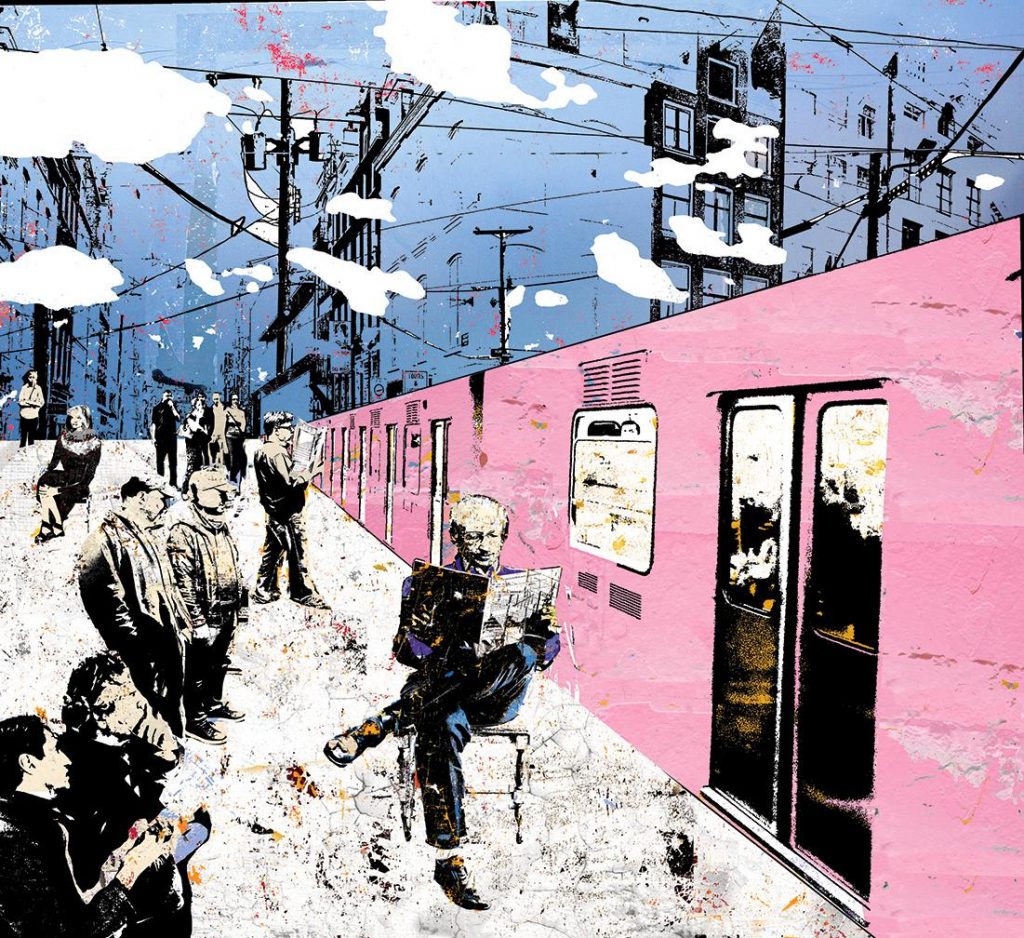
What Are We Waiting For
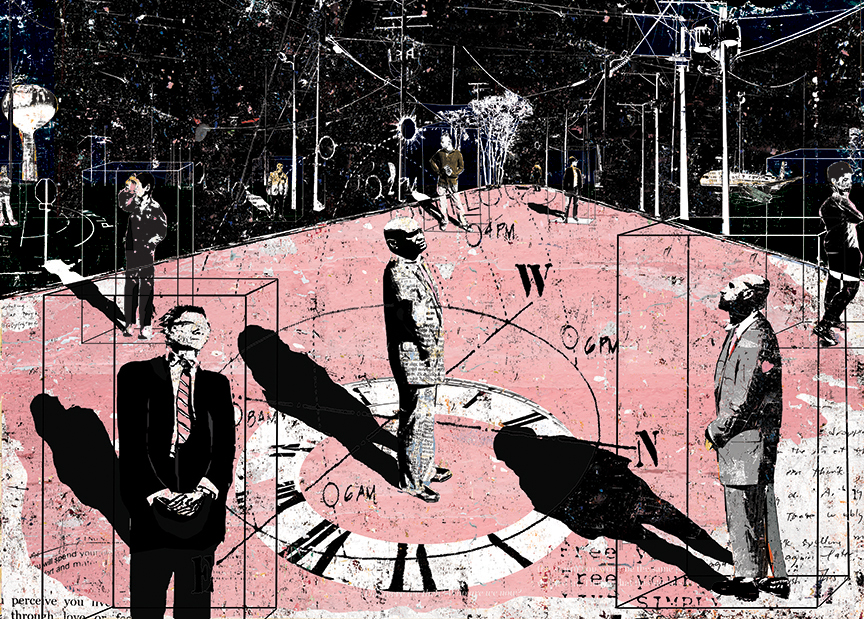
What Are We Searching For
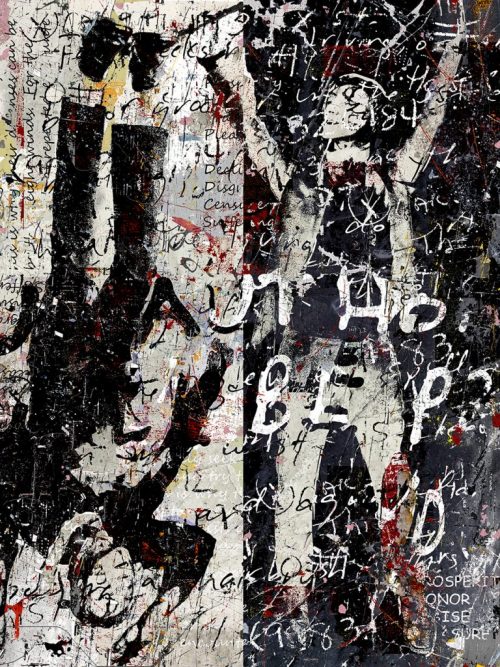 When I told someone recently about “The Circle” and the concept of the “eight winds” as described by the Buddhists, he said, “Oh, you mean life.” The “eight winds” are a group of juxtaposed influences which include: Prosperity and Decline; Honor and Disgrace; Praise and Censure; and Pleasure and Suffering. While the term “eight winds” might be a Buddhist term, we are all familiar with the “ups and downs” of life. The key, according to Buddhist thought, is not to be so emotionally moved by these winds–that is, not to be overly joyed by gain or overly grieved by decline. By remembering that life is a cycle and that good and bad both pass, come again, and pass again, we can become more accepting of both, and therefore more balanced.
When I told someone recently about “The Circle” and the concept of the “eight winds” as described by the Buddhists, he said, “Oh, you mean life.” The “eight winds” are a group of juxtaposed influences which include: Prosperity and Decline; Honor and Disgrace; Praise and Censure; and Pleasure and Suffering. While the term “eight winds” might be a Buddhist term, we are all familiar with the “ups and downs” of life. The key, according to Buddhist thought, is not to be so emotionally moved by these winds–that is, not to be overly joyed by gain or overly grieved by decline. By remembering that life is a cycle and that good and bad both pass, come again, and pass again, we can become more accepting of both, and therefore more balanced.
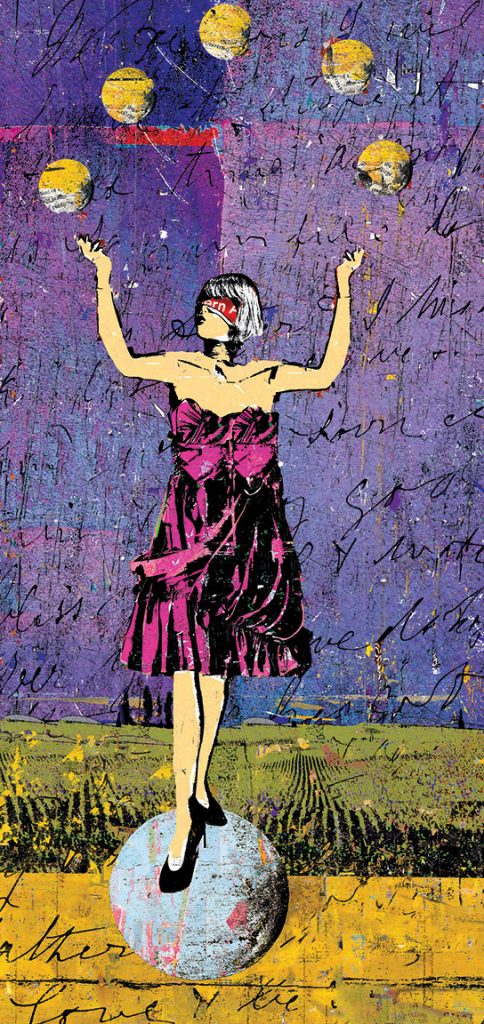
While I have created jugglers in my art in the past, I find this juggler the most complex and ambiguous of the group. I use jugglers to represent our conscious “juggling” of career, relationships, money, etcetera. The blindfold has represented many things over the centuries, but I am using it in this piece to represent the unconscious. By evoking the unconscious I am asking us to be mindful of all that we take on and to be aware of the blindfold that we all, to some extent, wear. Overall this is meant to be a hopeful image that shows our mastery but asks us to be mindful of what we are juggling.
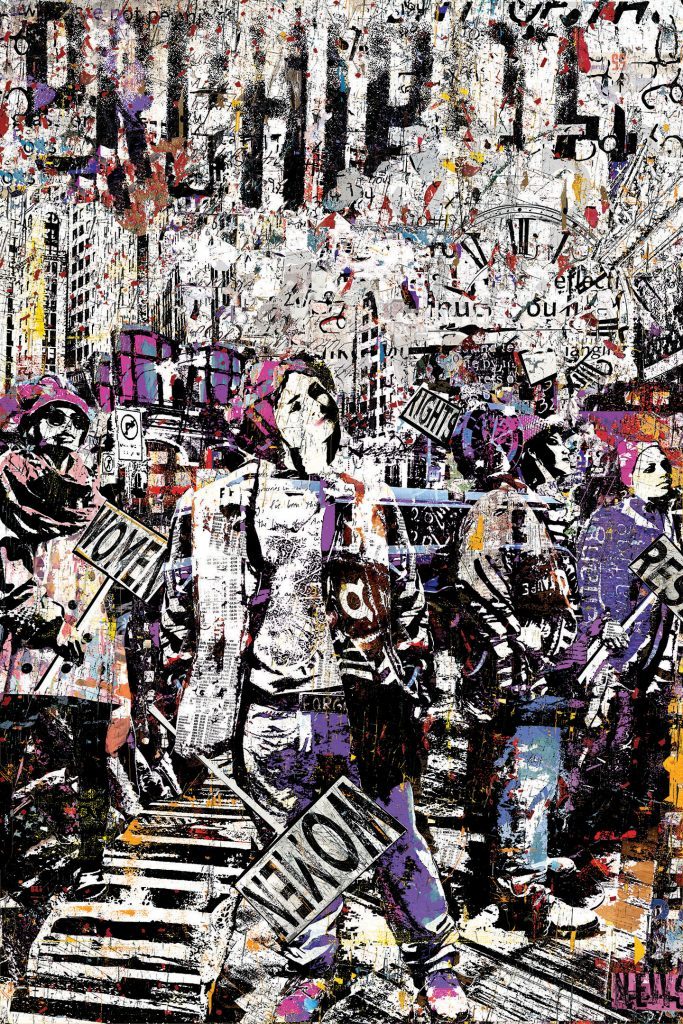
My work often shows men and women in contemporary settings dealing with time, career, money, distraction, and media in all forms. I do not create political art, so when I found myself with a piece that appeared to be a women’s protest piece, I was surprised. In the process of creating a piece that was meant to be simply contemporary women in an urban setting, it became obvious that it was more than that. As it turns out, I unconsciously placed the women in strong and defiant poses. Even the hats took on an iconic meaning. This piece flowed from me unexpectedly and effortlessly, and I felt that I must honor it.
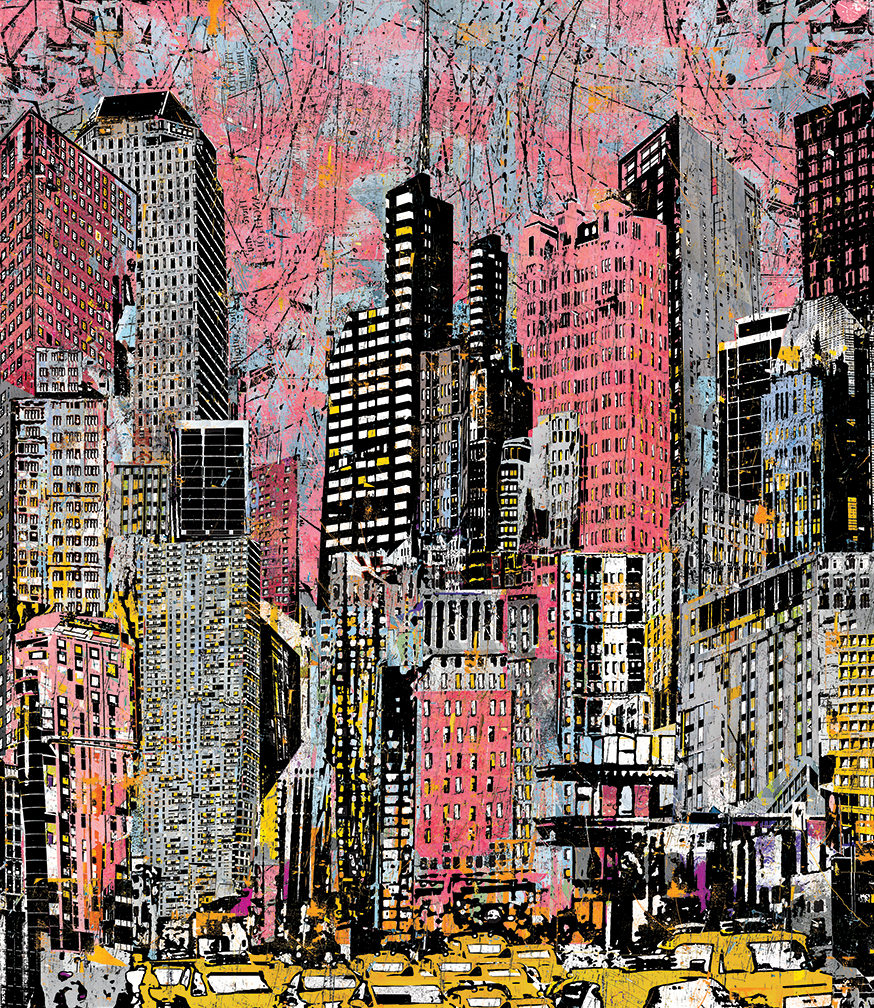
Growing up in rural Tennessee, I was fascinated by all things urban. The large metropolitan cities I saw on television glittered at night with lights and cars and well-dressed, beautiful people on their way to beautiful restaurants and parties. City life was a beautiful life and all urban people were living it, it seemed to me. This was, of course, a naive and romanticized vision. I somehow overlooked or discounted the crime stories and the images of less well-off people. Of course I now have a more complex and balanced view of cities. I still love the energy of them when I am in one, the people crowding the sidewalks, getting coffee at a local roasters, exploring and walking neighborhoods, and the museums and backdrop of beautiful buildings. My cityscapes are both a throwback to the days when I idealized cities and my way of honoring the reality of them, with all their fortunes and flaws.
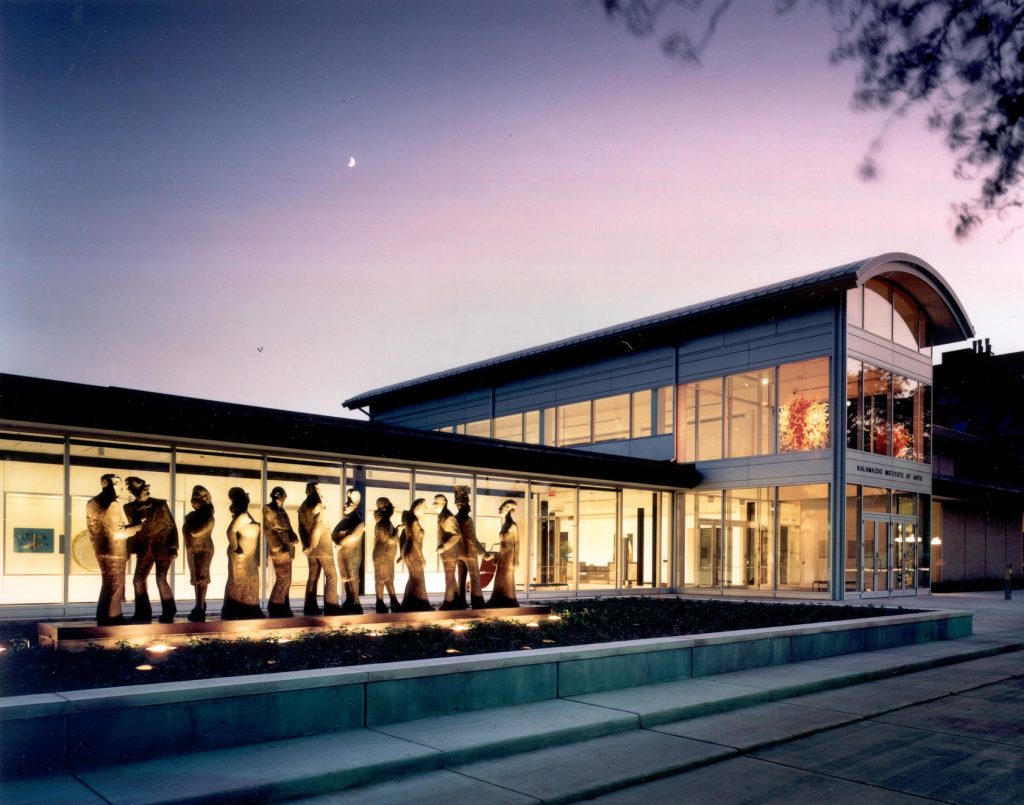
Psyche Meets Process : The Art of Digital Discovery with Daryl Thetford. Lecture on November 8, 2017 at the Kalamazoo Institute of Arts
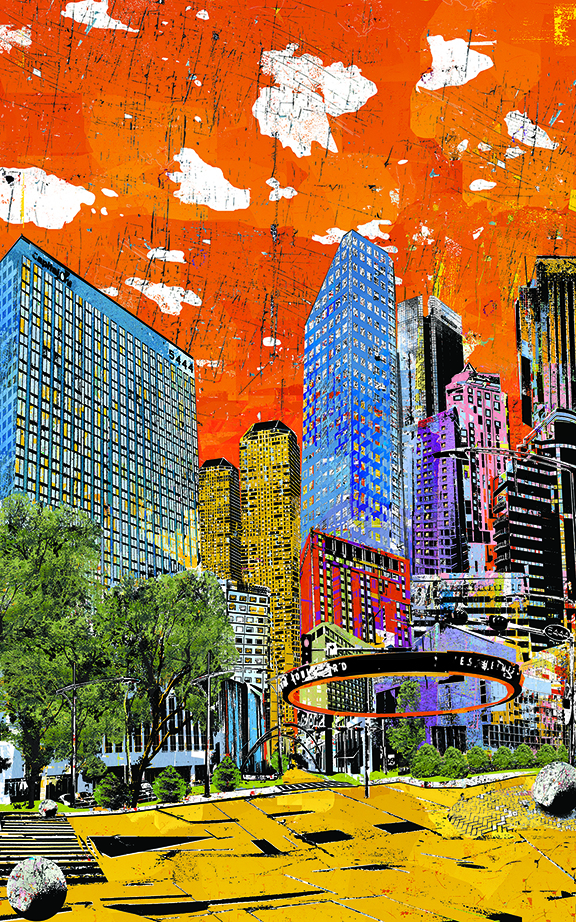
The 96″ x 60″ commission for 5444 Westheimer is complete and will be featured, along with 5 other pieces of mine in the lobby of this beautiful building ( located to far left in image )
My goals in creating this piece were to make the 5444 building prominent, include many of the significant buildings that define the area, and include the Galleria and some of its merchants. I brought in the flavor of the Westheimer/Galleria area by including the large silver rings that are installed over major intersections, the silver arches over some of the streets, some of the unique silver light poles, and the concrete balls that are on many corners. These landmarks make for the area’s highly original signature. The open space intentionally left in front of the cityscape also reflects the open feel of the Westheimer/Galleria area. Click Here for Full Image Description.
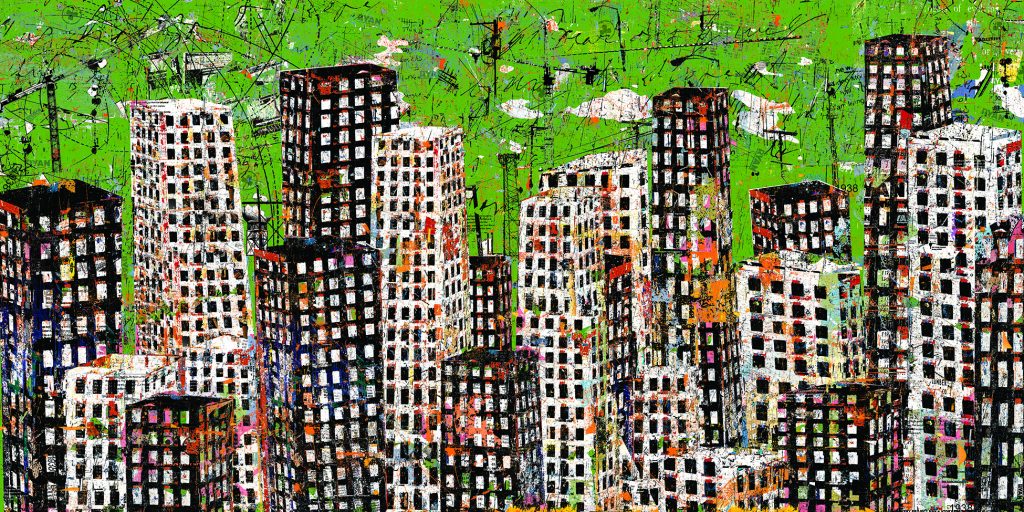
My cityscapes are normally intended to convey the energy of cities. In this case however, I see them conveying the energy of a city and of a corporation. Convey the energy of cities, the movement, color, sometimes chaos, but all within a framework. In this case, using Ryan s history, etc I think it also conveys the energy of a company with their involvement in so many projects around the world. Click Here to See Full Details of the Ryan Commission
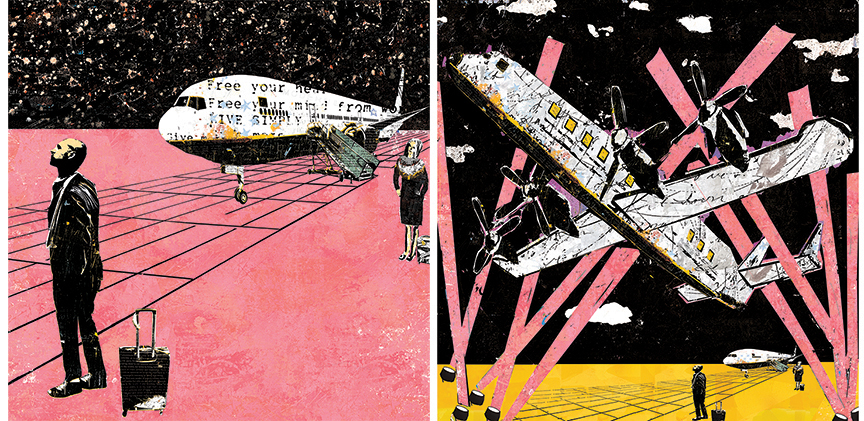
Contemporary Journey 1 96″ x 96″ and Contemporary Journey 2, 96″ x 96″, both inkjet on aluminum, will hang side by side in the main ticketing lobby.
While I wanted to establish these pieces clearly within the journey metaphor, I also wanted to create an intentionally ambiguous narrative which would allow the viewer to bring his or her thoughts, stories and interpretations to the pieces. What are the figures in the piece doing? Are they leaving or arriving? Are there second thoughts about a destination or departure, or is there great dream-like hope? Are the pieces tense or uplifting? I am asking the viewer to consider what hopes and/or anxieties we bring to any journey, physical or psychic, and what our relationship is to those thoughts and emotions.
I wanted these pieces to be contemporary as well as a homage to vintage graphic posters. The use of black, white, pink and gold as the primary colors links both time periods and styles, as does the simplicity of the pieces, but with the playfulness and ambiguity for which my work is known.
The components for this piece include photos of people I have posed, photographs of suitcases, actual airplanes photographed on runways, and astronomy illustrations and weathered paper and paint.
The writing on the foreground suitcase is from the Jungian psychologist James Hollis. The writing on the plane is found graffiti, the Tao, and an old letter to home found at an antique store.
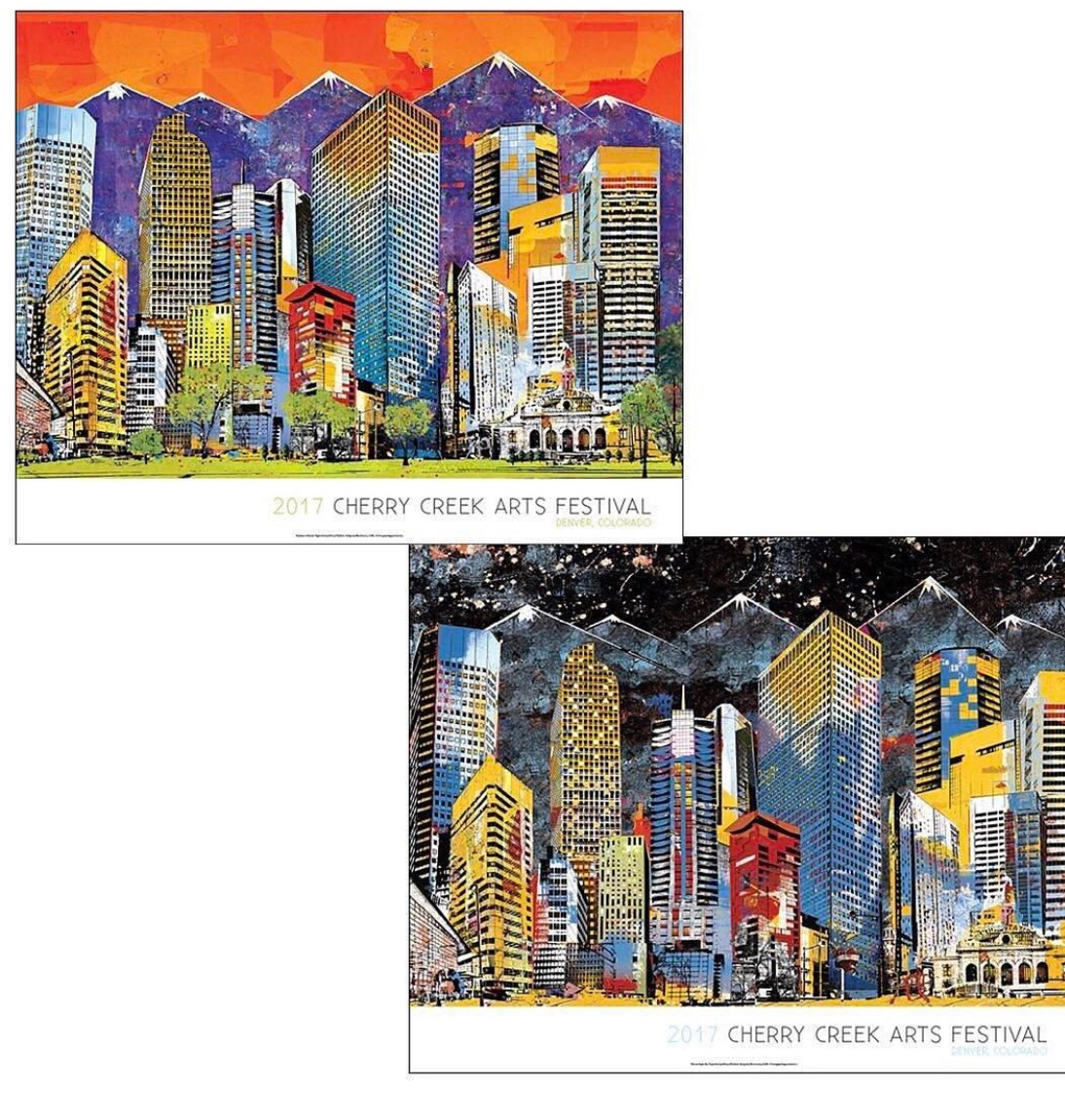
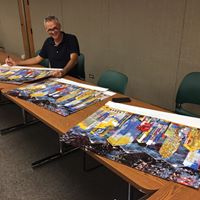
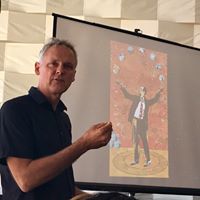
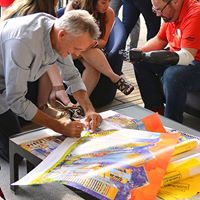
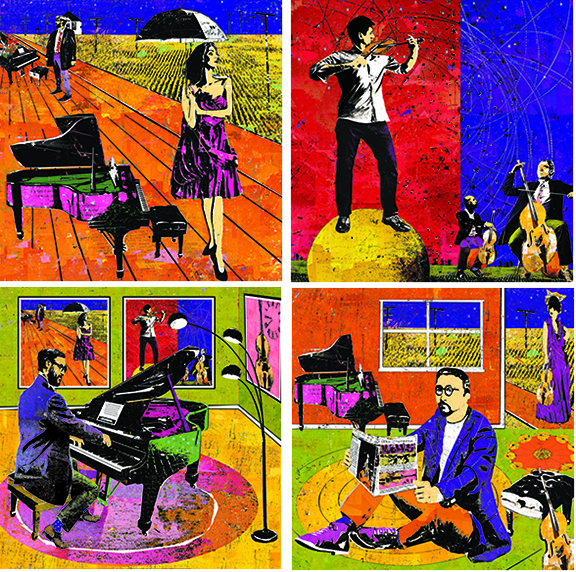
Understanding Contemporary Relationships ( series )
I stumbled across an article a few months ago discussing how a musical performance must function as a relationship if it is to be successful. One must have his or her own voice, allow others to have their voices/voice and work with this tension to create harmony. This, in turn, creates music.
I thought it would be an interesting challenge to use music in visual images that can show tension, harmony, balance or imbalance.
The resulting pieces became part of the solo exhibit, Contemporary Narratives at The Arts Company in downtown Nashville.
These pieces consist of hundreds of photographs of people who I posed, mannequins, pianos and musical instruments that I photographed in different locations, weathered paint and paper as well as text and other things, places and items I photographed.
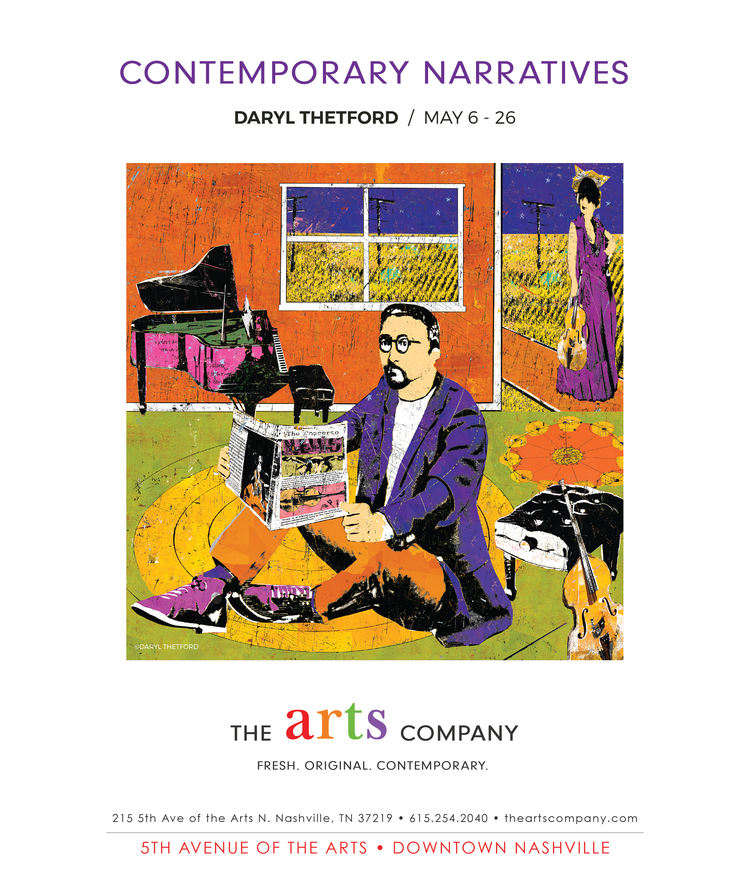
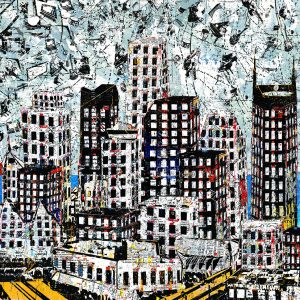
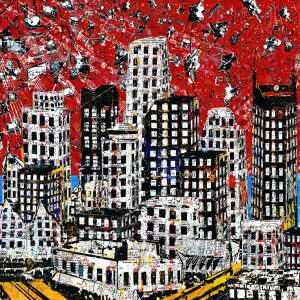
(L) Contemporary Nashville, Silver Sky, 60″ x 60″, Mixed Media, $425
(R) Contemporary Nashville, 48″ x 48″, inkjet on aluminum, $1850
This Nashville
ille piece is part of a larger series using music as a metaphor for relationship.
I stumbled across an article a few months ago discussing how a musical performance must function as arelationship if it is to be successful. One must have his or her own voice, allow others to have their voices/voice and work with this tension to create harmony. This, in turn, creates music.
This specific piece obviously incorporates this theme. Nashville’s has a long history with music so it is important to its past and also important today. This piece serves two roles, to honor the history and ongoing tradition of music in Nashville and as a reminder that as Nashville continues to grow and develop, it is working with all of the voices and allowing for this tension that will keep it in harmony.
This piece consists of hundreds of photographs. I photographed the downtown Nashville skyline as well as a number of individual buildings to create the foundation of the piece. I then added dozens of photographs of musical instruments, sheet music, text from various sources including the Tao and the Dow Jones stock market reports and photos of weathered paint and paper.
For the mixed media piece, I printed part of this image on clear acrylic, then bolted it to an aluminum composite board that I had coated with handmade paper, paint and molding paste.
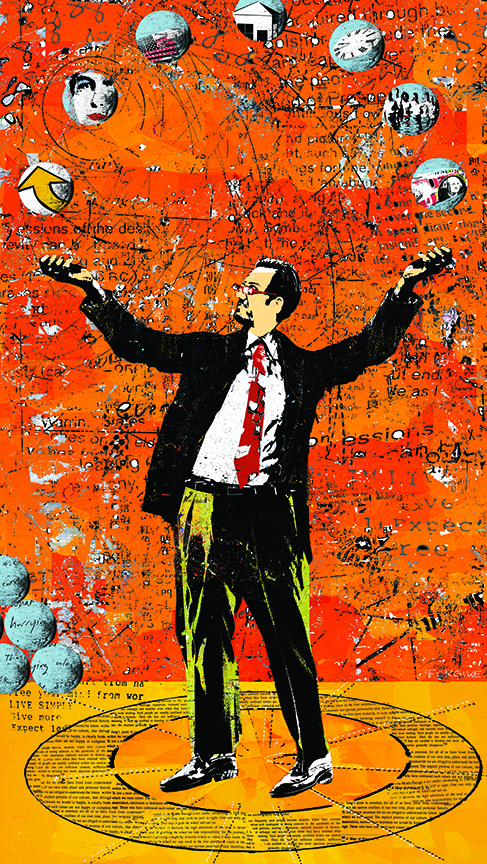
I continue to be drawn to a Juggler as an image, this being my third version. This is not a conscious decision, at least to begin with, but I find that there is no better image to symbolize our contemporary lifestyle as someone with so much “in the air”.
In this piece, from left to right, he is juggling career or upward mobility, relationship, nation/news/politics, home, time, religion/spirituality and money. He has more balls stacked on the ground beside him to add to the group he is juggling or to replace some should they be dropped or should he let something go.
Below the waiting stack is a partial obscured concept I encountered and photographed stenciled on a bathroom wall. It says Free Yourself from Worry, Live Simply, Give More, Expect Less.
In the background is both English and Chinese versions of text from the Book of Five Fold Happiness, which is an exploration of happiness in relationships, prosperity, longevity, ( and two others I cant think of )
On his tie is images of computers, phones, tablets and other modern day work and communication devices.
Finally, he is standing in a circle which may suggest a mandala, an ancient symbol that suggests that we create the world we live in. Surrounding this is writing from the Jungian Psychologist, James Hollis
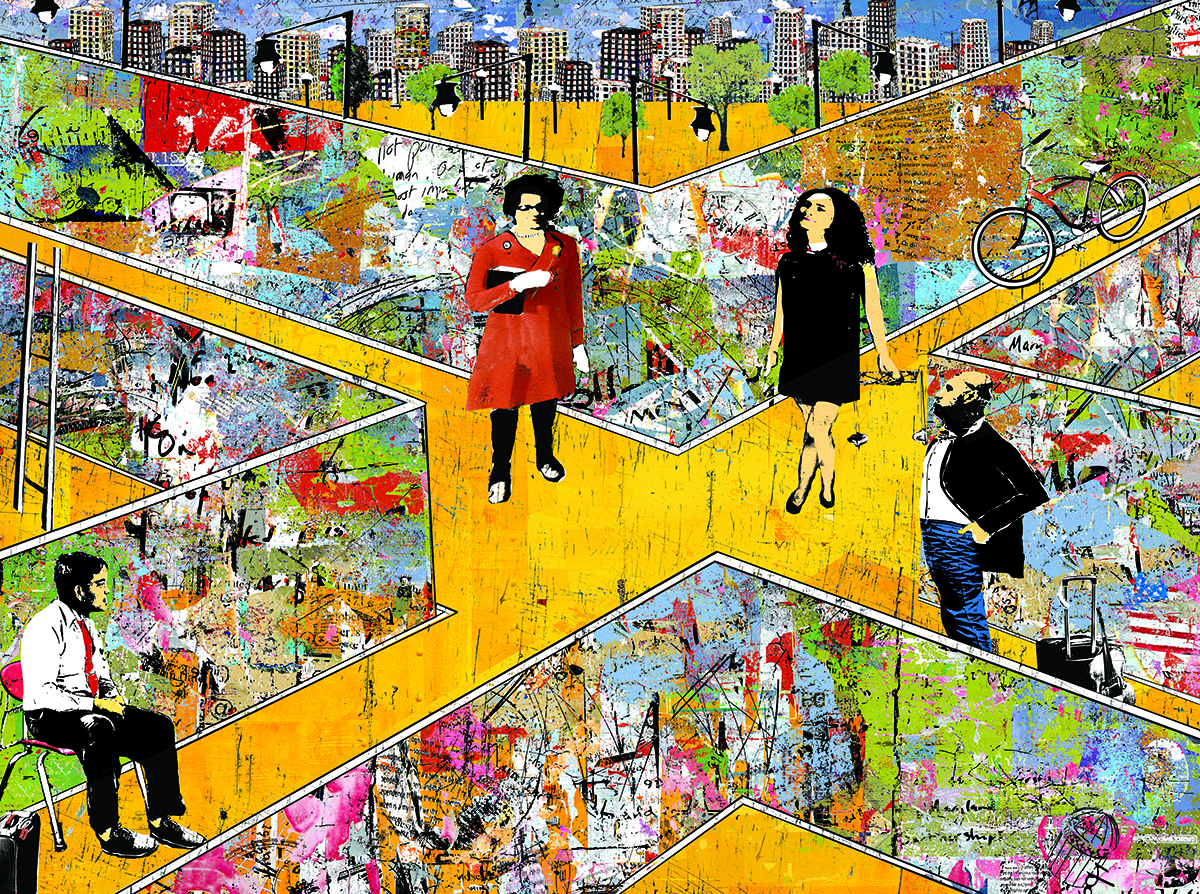
Crossroads
120″ wide x 89″ tall. Also available in other sizes.
There is no denying that “Walls” are powerful symbols with many possible intents and meanings. Crossroads is an exploration of walls as they speak to division and otherness.
In the movie Fences, the main character Troy Maxson, played by Denzel Washington, is building a physical fence in his yard. He is also, in his personal life, building a wall of anger, judgement…for full explanation click here.
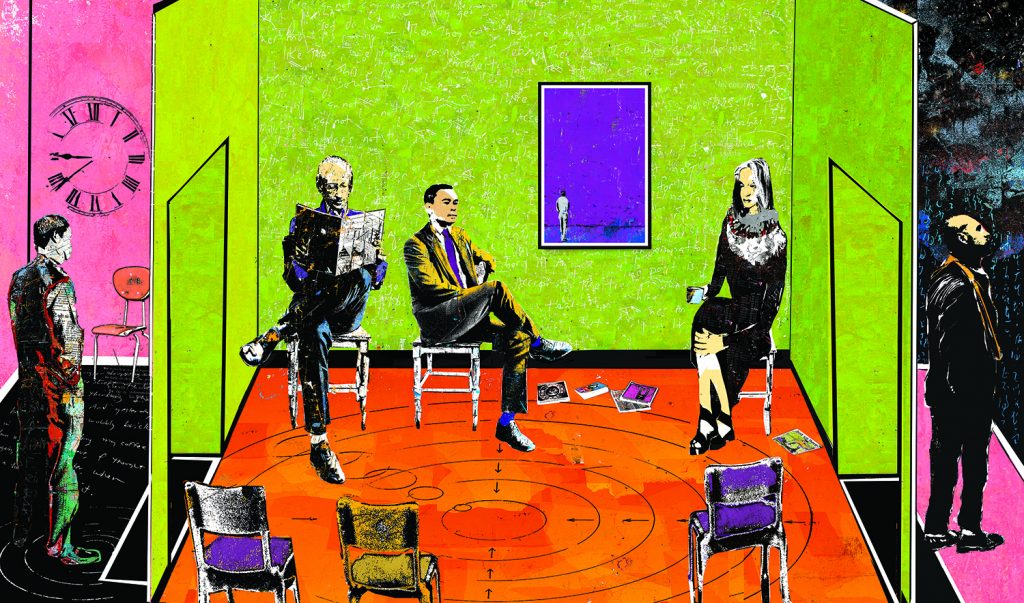
The Waiting Room, 2017. 95″ tall x 160″( edition of 1 ) to 31″ tall x 53″ wide ( edition of 12)
Transition
Recently a friend was describing an NPR Radio Lab episode(Afterlife season 6, episode 2 http://www.radiolab.org/story/91680-after-life/ ) he heard, which was about death. In the episode, a writer and scientist was talking about three deaths and a waiting room. The story, as my friend told it to me, grabbed my attention; I immediately thought it would be an interesting art piece.
A few days later, I was listening to Radio Lab when that very episode was rebroadcast. I was struck by the coincidence, and struck again by the concept and the possibilities for imagery that it conjured. I ordered the book by neuroscientist David Eagleman,, where this tale of three deaths and a waiting room originated. The book, SUM: Forty Tales from the Afterlives, is a collection of his essays which explore what the afterlife might be like. All of the stories are well written and immensely creative. But it was Metamorphosis, that had aired on Radio Lab, that I found myself still wanting to pursue.
Metamorphosis is about the process of waiting to full explanation at this link
Ormond Art Museum and Gardens, Ormond Beach, Florida.
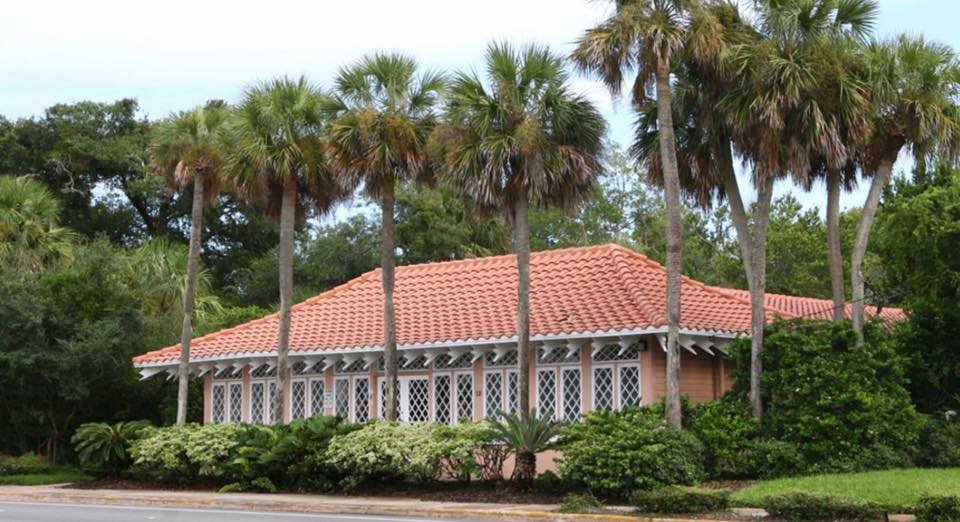
Reflections on Self and Society, Solo Exhibit, Artist Talk and Opening on March 16. Dates of show are March 16-April 22, 2017
_________________________________________________________________________________
The Arts Company, 5th Avenue, Nashville, Tennessee
Understanding Contemporary Relationships, Solo Show at the Arts Company, June, 2017. Downtown Nashville, Tennessee.
___________________________________________________________________________
Artist-in-Residence for The Gathering at Keystone College
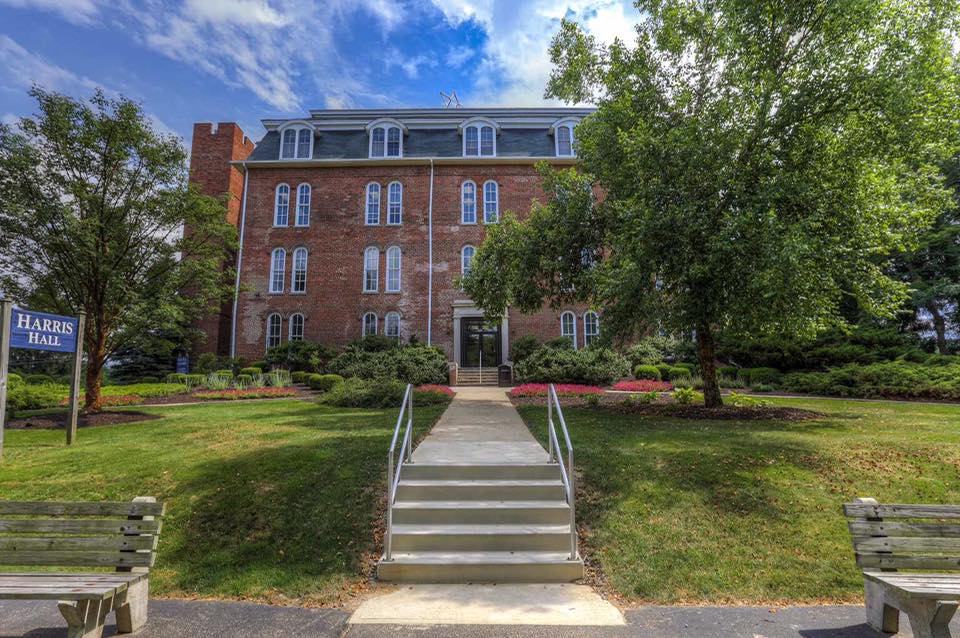
July 14-16, 2017 I will be Artist in Residence at The Gathering at Keystone College. The theme will be …ways to find common ground among bitter rivals in religion, politics, ethics, race, and the arts and sciences that have deeply divided America.
http://thegatheringatkeystone.org/schedule/
________________________________________________________________________
Solo Exhibit, Arts at the Airport, Nashville International Airport, Sept 4, 2017- Feb 25, 2018
ABOUT ARTS AT THE AIRPORT

Created in 1988 by the Metropolitan Nashville Airport Authority (MNAA), Arts at the Airport is an ever-growing, ever-changing showcase of cultural diversity and creative talent in Tennessee. The terminal and surrounding facilities at Nashville International Airport were designed to incorporate rotating public art exhibits and permanent acquisitions.
The art in image above is not mine, but from a previous exhibiting artist.
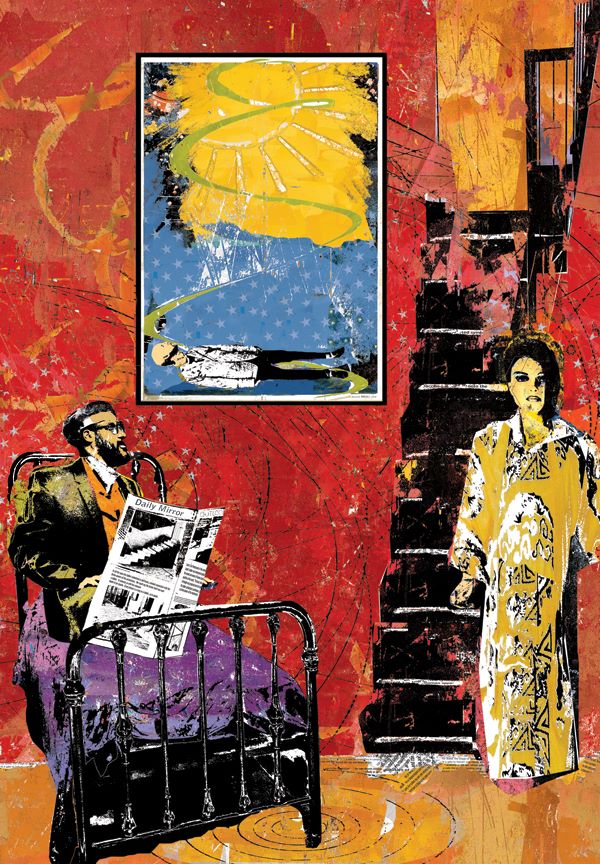
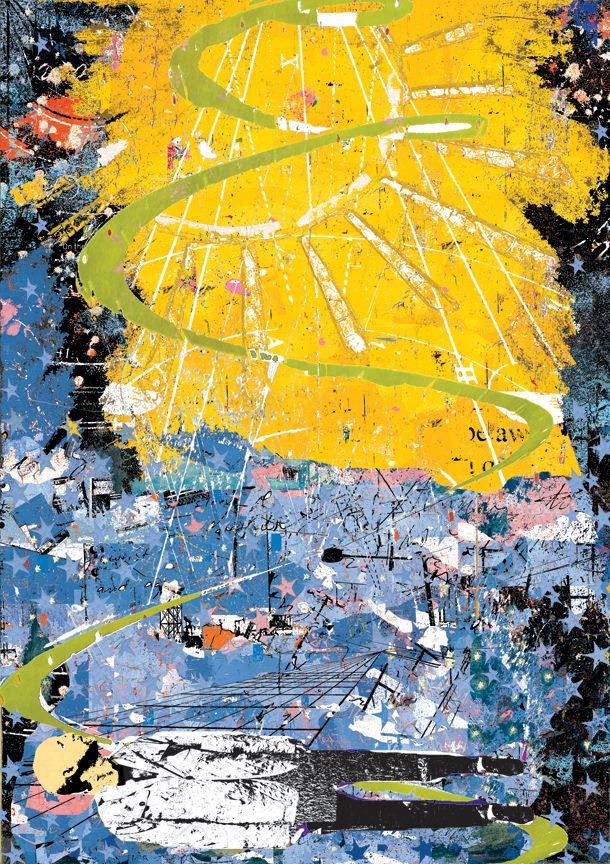
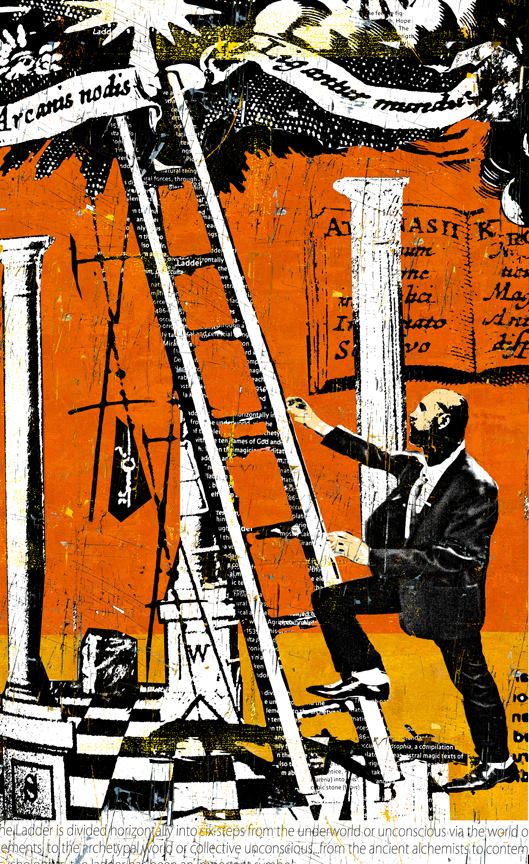
Jacob’s Ladder and a Few Words About My Art and Mythology
I fell in love with myth the same way many of us did: through the conversations of Joseph Campbell and Bill Moyers in the WHAT PBS series, The Power of Myth. I was drawn further into mythology through the book ReVisioning Psychology, by the controversial Jungian psychologist James Hillman. But although I understood the connection…explanation continued here.
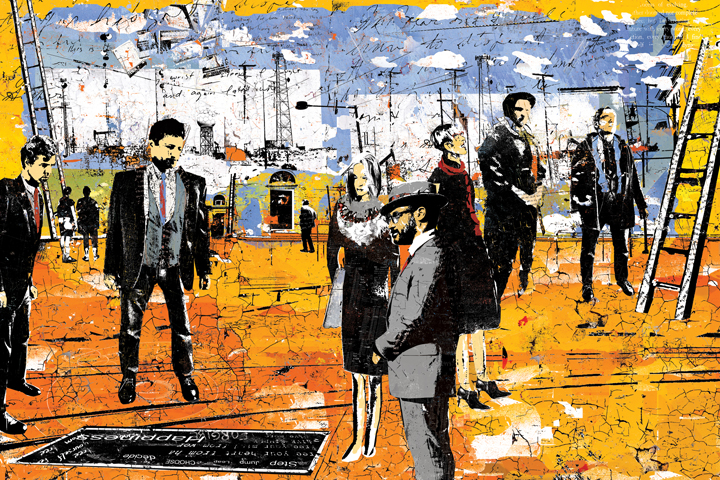
The Discovery of Choice, inkjet on aluminum, 120″ x 180″, 2016 ( see bottom of page for more sizes and pricing )
I was driving across the west last year listening to one of my favorite NPR podcasts, On Being. During one particular episode, host Krista Tippett was talking with the poet Marie Howe about life, poetry, and all things spiritual and psychological. I will confess that…continue here
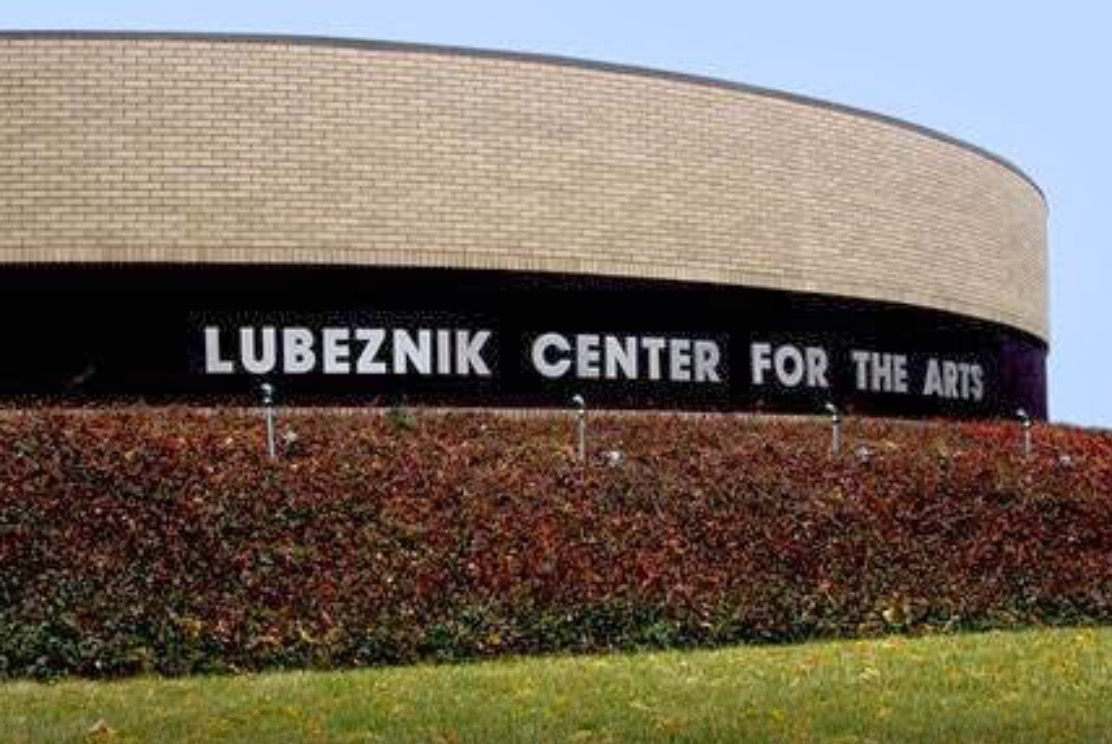

Images of Lubeznik Center with past exhibit ( my work not shown in this image ). The Lubeznik Center for the Arts is located approximately 58 miles west of Chicago.
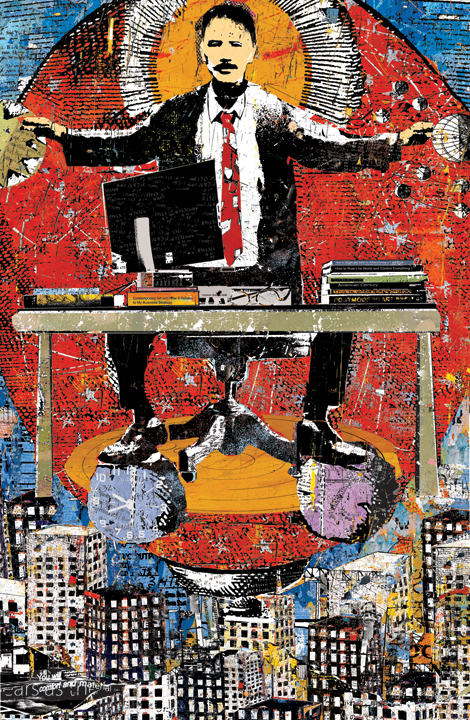
The 1663 illustration, Metamorphosis Planetarum, by the alchemist J. de Monte-Snyders served as an inspiration and starting point for my piece, The Challenge of Creation (2016).
In pondering this creation illustration from the 1600s, I tried to envision what a modern day version might look like. The question turned into what would a modern day creator look like?
Instead of going with a mythical God-like creator, as J. de Monte-Snyders did, I chose to represent each of us as creator. We all participate in click here for rest of the story
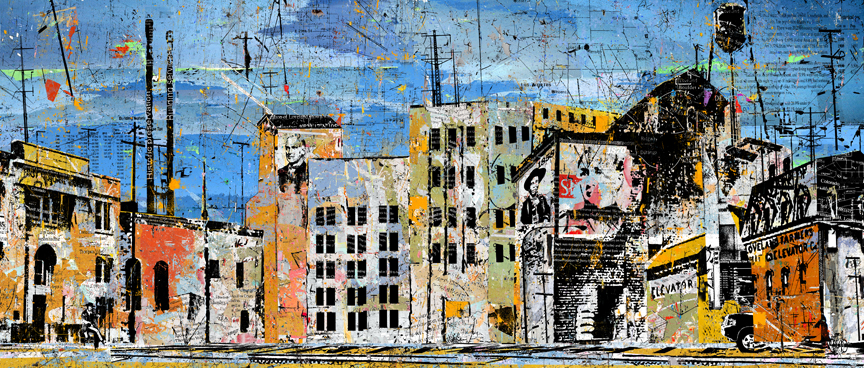
Anatomy of a Mural
The RFP ( national Request for Proposal ) asked that the mural be urban, edgy, vibrant and colorful. In creating the mural, I wanted to incorporate Loveland landmarks and history. The city has many beautiful and historic buildings, but when I looked at including them all in the mural, it made for a more historic and peaceful (as opposed to urban and edgy) piece. So in the end, I settled on five primarily industrial buildings.
Once I had the basic structure of the image, I began cutting and pasting multiple photos of weathered paint and paper, utility poles, street signs, words from documents and other images and text for color and texture. read about the entire mural and the key to finding and understanding everything in it at this link
corporate collection and wil reproduce all four images for the group’s holiday cards. When asked to create the initial Nashville image, I immediately had a vision of an iconic cottage sitting in a snow covered field, and thought about how unexpected it would be to see their downtown high-rise in place of the cottage. That vision was the genesis of the four pieces. You can see the other three images here.. other images
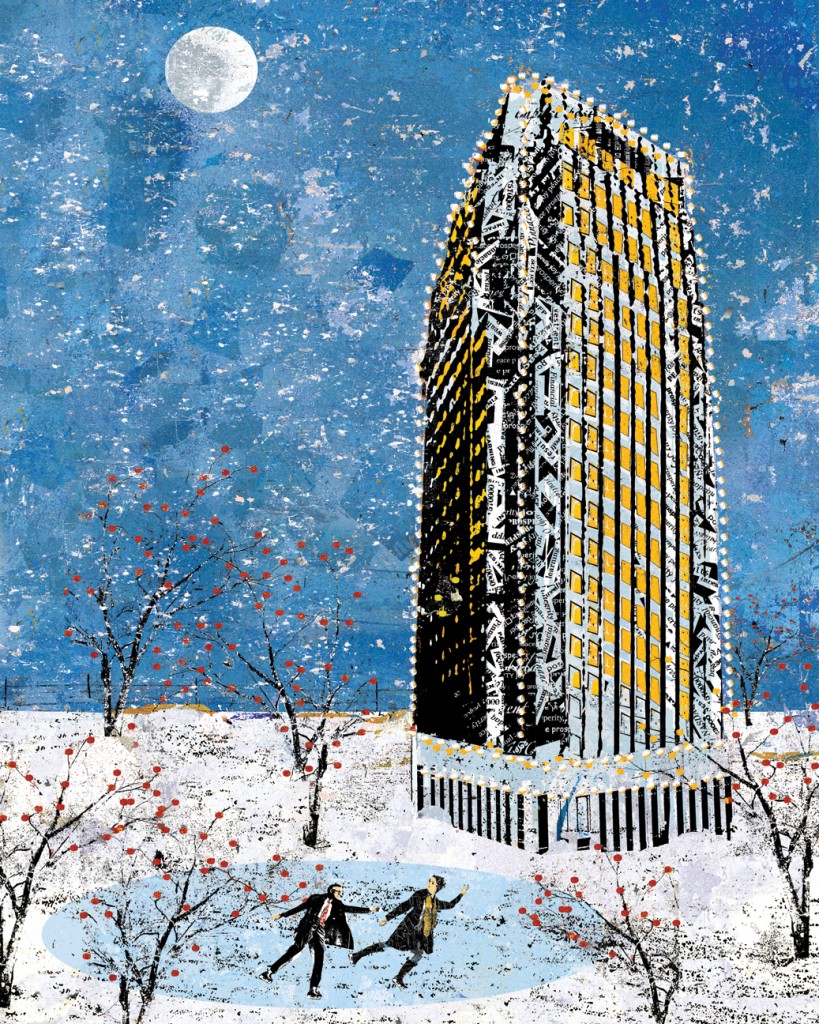
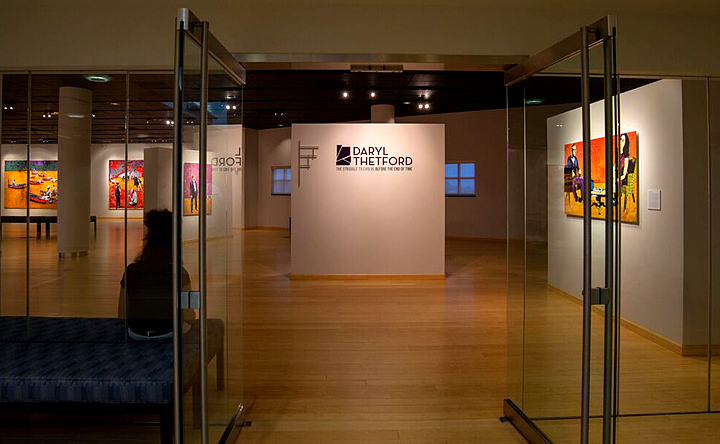
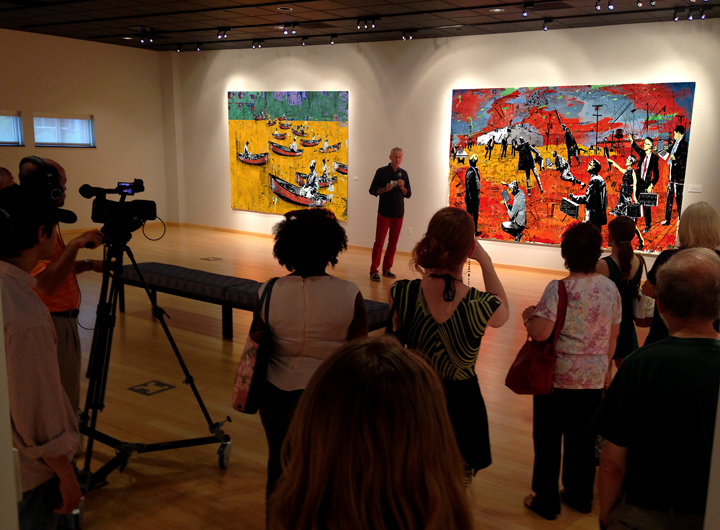
See more images from the July 9, 2015 artist talk and opening here….TGPC Opening.
Also, thanks to Penny, Cindy and Lenore for the posters, catalog, postcards, images, video and the large amount of work that went into the show. Link to the Gallery at Penn College site.
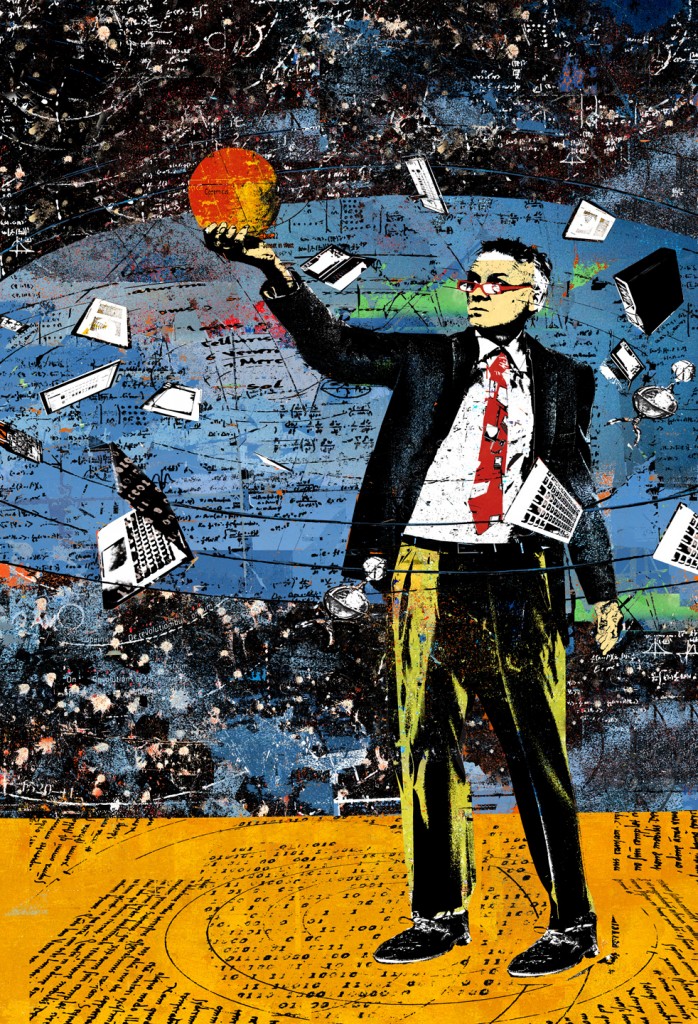
Arrow Five Years Out Art Challenge
Arrow Electronics and the Cherry Creek Arts Festival invited artists from all over the world to explore the notion of innovation and to express, through their particular medium, what Five Years Out might look like. From the proposals submitted, five projects were selected to become a part of Arrow Electronics’ prestigious art collection.
My piece, r+Evolution ➔2020, was one of the five selected. Below is my vision statement in response to the question of innovation, change, and the future.
r+Evolution ➔2020
How do we engage with a rapidly changing world? What is the relationship we should be developing with change five years out–or even five weeks out?
My piece takes inspiration from Copernicus, who revolutionized the way we think about our place in the universe by offering a view of a Sun-centered, as opposed to Earth-centered, solar system. In r+Evolution ➔2020, Copernicus stands at the center of contemporary society, surrounded by the tools of Renaissance astronomy, contemporary mathematical symbols, and electronic media including workstations, computers, laptops, cell phones, tablets, and an oscilloscope.
While Copernicus was not the first to propose the concept of a sun-centered universe, “…he was the first to work out his theory in full mathematical detail and to create a complete and general system combining mathematics, physics, and cosmology” (Eric Weisstein, PhD). In doing this, he not only revolutionized our thinking, he shaped both the conceptual and the tangible future.
Most people agree that change, including developments in technology and shifting societal norms, is imperative if we are to expand our understanding of our world and move forward. But with change often comes discomfort, and we often do not meet it with openness. Copernicus knew that his ideas would cause uproar, but he also knew that his discoveries were necessary to the world, that they were the precursor to a thoughtful, progressive, and informed dialogue about the universe and our place in it.
In creating r+Evolution ➔2020, I placed a modern day Copernicus in the center of the image encircled by his own diagram of the cosmos (published in 1543). Orbiting around him are mathematical equations, a computer workstation, an Arrow Electronics oscilloscope, a globe from the Renaissance period, laptops, keyboards and tablets. In the background is the “universe,” which I created by piecing together photographs I have taken of weathered paint, mathematical equations, and Copernicus’s own diagrams. The “stars” are photographs of splattered concrete on the side of a train car. On his tie are additional references to media and technology.
Today’s technological advances are the result of the confluence of ancient and modern revolutionary thinkers. It is in merging the revolutionary with the evolutionary, and the theoretical with the practical, that they build the bridge between where we are and where we will be.
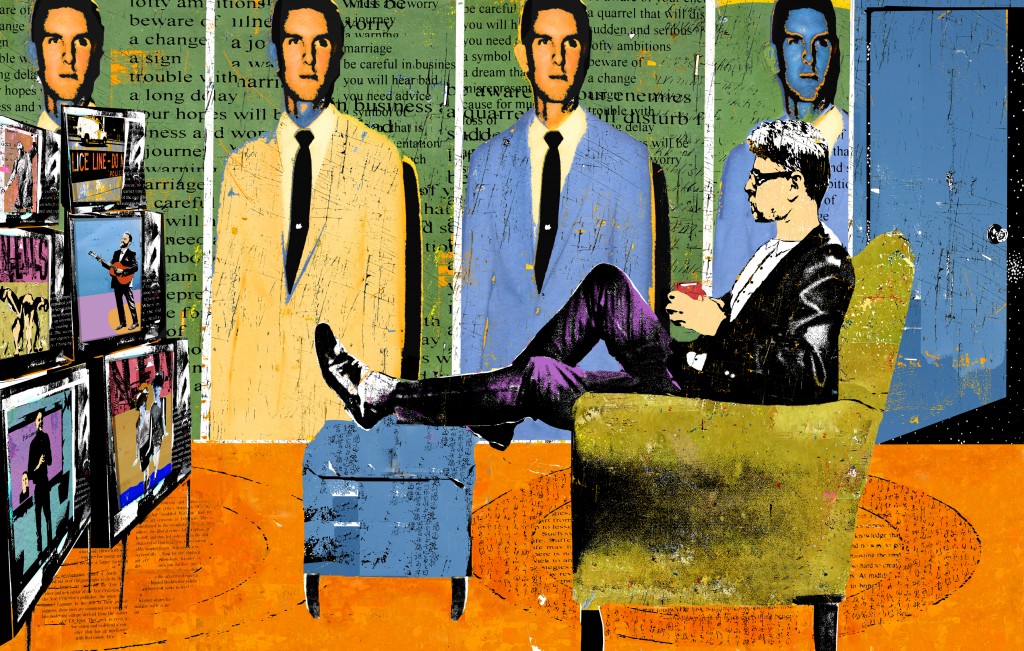
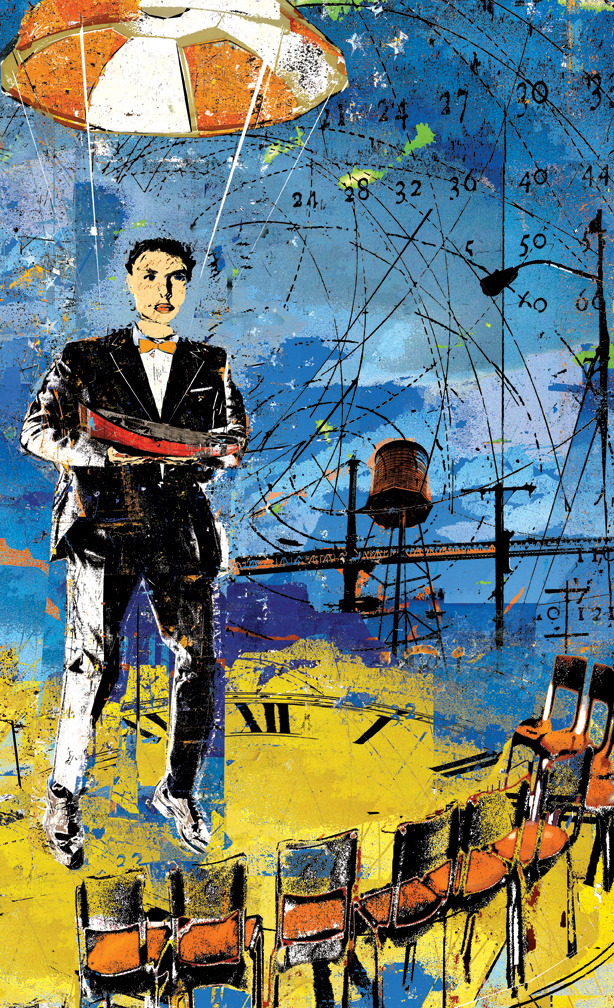
Man with Parachute
Last year I jumped off a mountain. Since I am afraid of heights, I had not planned such a thing, but I was on a trip and had vowed to a friend to be more to experience. Which is how the 9200 foot tandem paraglide jump in Sun Valley, Idaho happened.
I have been asked by a number of people if it changed me. The answer is a qualified yes. There was no big “aha!” moment where I suddenly realized I was free and had no fears. But there was a subtle shift from my lifelong tendency, when afraid, to say “no,” to being able to remind myself that I jumped off a mountain, which makes whatever is scaring me no longer so big.
This piece is was inspired by that jump. It is about the metaphor of taking a leap into something that we know probably will not kill us, but scares us terribly anyway. And it is about bringing something back: the courage to jump again and again.
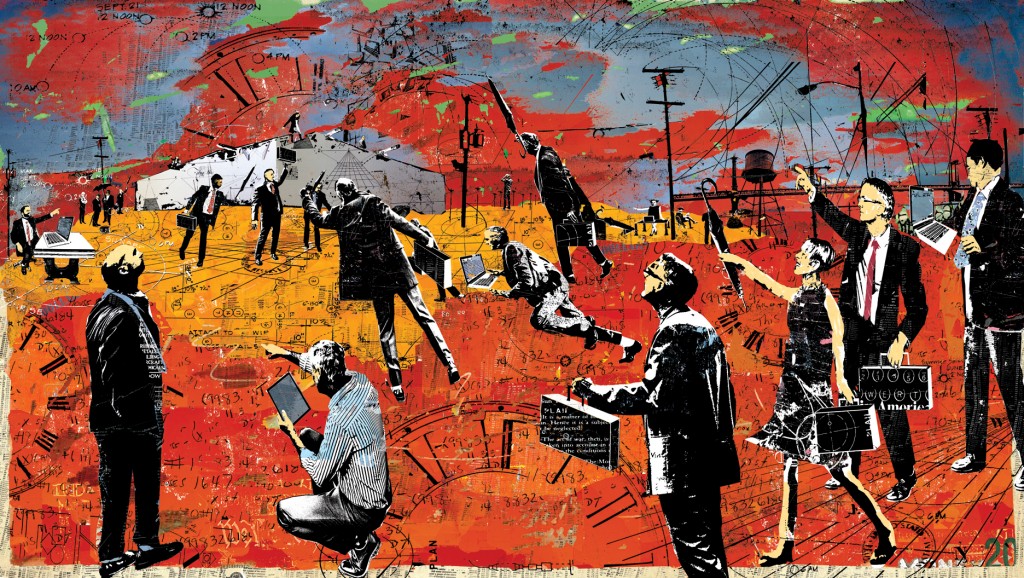
Last year at an open air flea market on the pier in Barcelona, I found a group of illustrated WWI cards made by the chocolate company Chocolate Amatller. The cards were bright and colorful and hardly conveyed the gravity of war. I bought thirty and kept them out on a table for inspiration. They were the starting point for this piece.
The Search for Balance on first glance may appear to be a statement about work, success, and career competition as war, and certainly I had Sun Tzu’s The Art of War in mind when building it. But I also had Middle Passage, by Jungian Psychologist James Hollis, about the journey and struggle of midlife on my mind, as well as Lao Tzu’s Tao Te Ching which encourages one to go with the flow of life rather than fight against it.
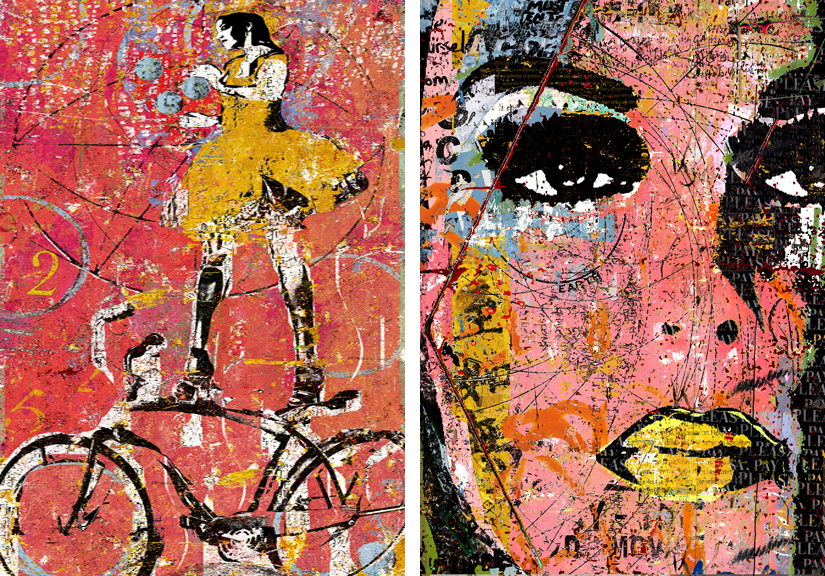
ABC’s hit series Nashville has bought the rights to use two of my pieces on the set for some upcoming shows. They will appear in Christina Aguilera’s character Jade St John’s dressing room. Both pieces are 72″ x 48″ so they should be hard to miss. Date TBA.
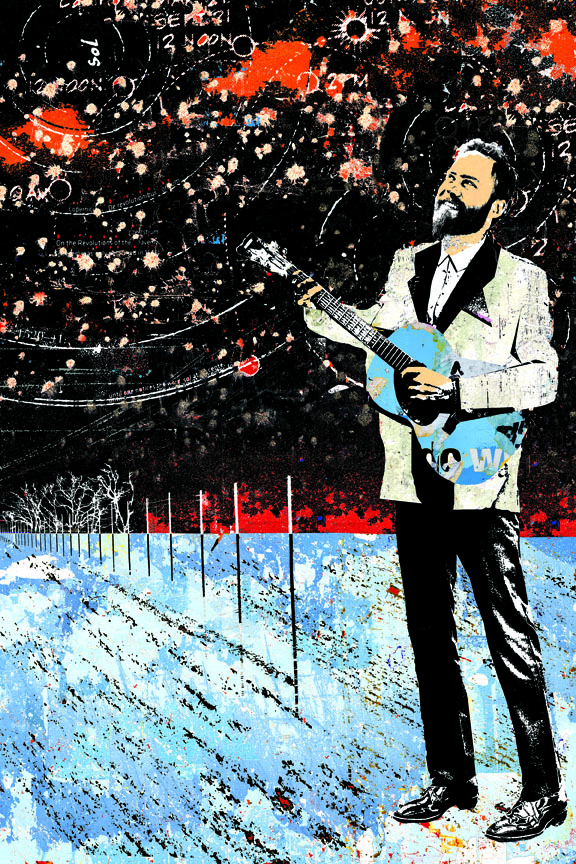
I begin most of my pieces with a clear idea of what they are about and an outline of how they will look. With a few images, however (such as The Man with Cello) I began with a visual concept and had to discover their meaning as I went along. These are the hardest pieces to do.
These two pieces, Man on Ice and Man on Fire, I had to discover the meaning as I went along. When I was in St Petersburg, Florida last month I watched a boy throwing bread in the air for a group of seagulls. They were all hovering over him and it made for an amazing visual. I stood and watch them for a few minutes, took a few photos, then moved on. For this piece, I had a clear vision of a man playing a guitar to the sea gulls, but I did not have the meaning behind it.
So I posed a friend playing a guitar and placed him in the image and began searching for the meaning. I looked into mythology, psychology and religion to see what might resonate. Maybe he is Orpheus, the Greek musician and poet who could charm all things. Maybe the birds are messengers. A funny thing happened on the way to finding the meaning. I realized the birds, originally my favorite part of the image, had to go. This is what writers call “ killing your darlings”.
This left me at the beginning again. Now, what is the piece about? Who is this man?
What or who is he looking at? Is he playing the guitar for himself? Did he just want peace and solitude?
As I began working with it, the clues began taking shape. Twice in two days, I came across Copernicus’s illustration, Revolutionibus Orbium Coelestium (On the Revolutions of the Heavenly Spheres). His illustration places the Sun, not Earth, at the center of the solar system. Since it kept appearing, I included it in the piece. I also added a diagram of a Sun chart, showing it at different locations in the sky during various times of the year, and photos that I’ve taken of splashes of concrete on a train car, which looked to me like stars. I added the fence for visual depth and also to suggest limits or boundaries, imposed or imagined. There is either a fire in the background or a brilliant sunrise.
If I am to understand this piece, I have to begin with the Copernicus illustration. It seems obvious that placing the Sun instead of the Earth at the center of the solar system is a psychological shift, which is a metaphor for the fact that we ourselves, are not the center of the universe.
The figure in both pieces also seems to relish his aloneness. If there is a fire, he is not disturbed by it. This could suggest that it is a psychological fire, something burning inside, or being cleared away or purified. Perhaps in his solitude he has discovered that he is not the center of the universe, and is relieved; perhaps he is celebrating or singing a song of gratitude.
